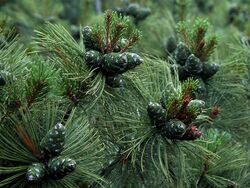Biology:Pinus pumila
| Pinus pumila | |
|---|---|

| |
| Scientific classification | |
| Kingdom: | Plantae |
| Clade: | Tracheophytes |
| Clade: | Gymnospermae |
| Division: | Pinophyta |
| Class: | Pinopsida |
| Order: | Pinales |
| Family: | Pinaceae |
| Genus: | Pinus |
| Subgenus: | P. subg. Strobus |
| Section: | P. sect. Quinquefoliae |
| Subsection: | P. subsect. Strobus |
| Species: | P. pumila
|
| Binomial name | |
| Pinus pumila (Pall.) Regel[2]
| |
| Synonyms[2] | |
| |
Pinus pumila, commonly known as the Siberian dwarf pine, dwarf Siberian pine,[1][3] dwarf stone pine,[1] Japanese stone pine,[3] or creeping pine,[4] is a tree in the family Pinaceae native to northeastern Asia and the Japan . It shares the common name creeping pine with several other plants.
Description
The Siberian dwarf pine is a coniferous evergreen shrub ranging from 1–3 metres (3–10 feet) in height, exceptionally up to 5 m (16 ft), but may have individual branches that extend farther along the ground in length. In the mountains of northern Japan, it sometimes hybridises with the related Japanese white pine (Pinus parviflora); these hybrids (Pinus × hakkodensis) are larger than P. pumila, reaching 8–10 m (26–33 ft) tall on occasion.
The leaves are needle-like, formed in bundles of five and are 4–6 centimetres long. The cones are 2.5–4.5 cm long, with large nut-like seeds (pine nuts).
Distribution
The range covers the Far East, Eastern Siberia, north-east of Mongolia, north-east of China, northern Japan and Korea.[3] Siberian dwarf pine can be found along mountain chains, above the tree line, where it forms dense, uninterrupted thickets; it also grows on the headlands above the Okhotsk and Bering Seas, Tatarsk and Pacific coast (the Kurils).
P. pumila grows very slowly. It can live up to 300 and, in some instances, 1,000 years.[5][full citation needed] In the colder conditions of Siberia, there are specimens which are 250 years old and older.
Ecology
The seeds are harvested and dispersed by the spotted nutcracker (Nucifraga caryocatactes).
Cultivation
This plant is grown as an ornamental shrub in parks and gardens. The cultivar P. pumila 'Glauca' has gained the Royal Horticultural Society's Award of Garden Merit.[6]
See also
References
- ↑ 1.0 1.1 1.2 Farjon, A. (2013). "Pinus pumila". IUCN Red List of Threatened Species 2013: e.T42405A2977712. doi:10.2305/IUCN.UK.2013-1.RLTS.T42405A2977712.en. https://www.iucnredlist.org/species/42405/2977712. Retrieved 19 November 2021.
- ↑ 2.0 2.1 "Pinus pumila". World Checklist of Selected Plant Families (WCSP). Royal Botanic Gardens, Kew. http://wcsp.science.kew.org/namedetail.do?name_id=380284.
- ↑ 3.0 3.1 3.2 {{citation | mode = cs1 | title = Pinus pumila | work = Germplasm Resources Information Network (GRIN) | url = | publisher = [[Organization:Agricultural Research ServAgricultural Research Service (ARS), United States Department of Agriculture (USDA) | access-date = 18 December 2017 }}
- ↑ Fukui, K.; Sone, T.; Yamagata, K.; Otsuki, Y.; Sawada, Y.; Vetrova, V.; Vyatkina, M. (2008). "Relationships between permafrost distribution and surface organic layers near Esso, central Kamchatka, Russian Far East". Permafrost and Periglacial Processes 19 (1): 85–92. doi:10.1002/ppp.606.
- ↑ Koropachinsky, Vstovskaya, 2002
- ↑ "RHS Plant Selector - Pinus pumila 'Glauca'". https://www.rhs.org.uk/Plants/58231/Pinus-pumila-Glauca/Details.
External links
Wikidata ☰ Q243964 entry
 |







